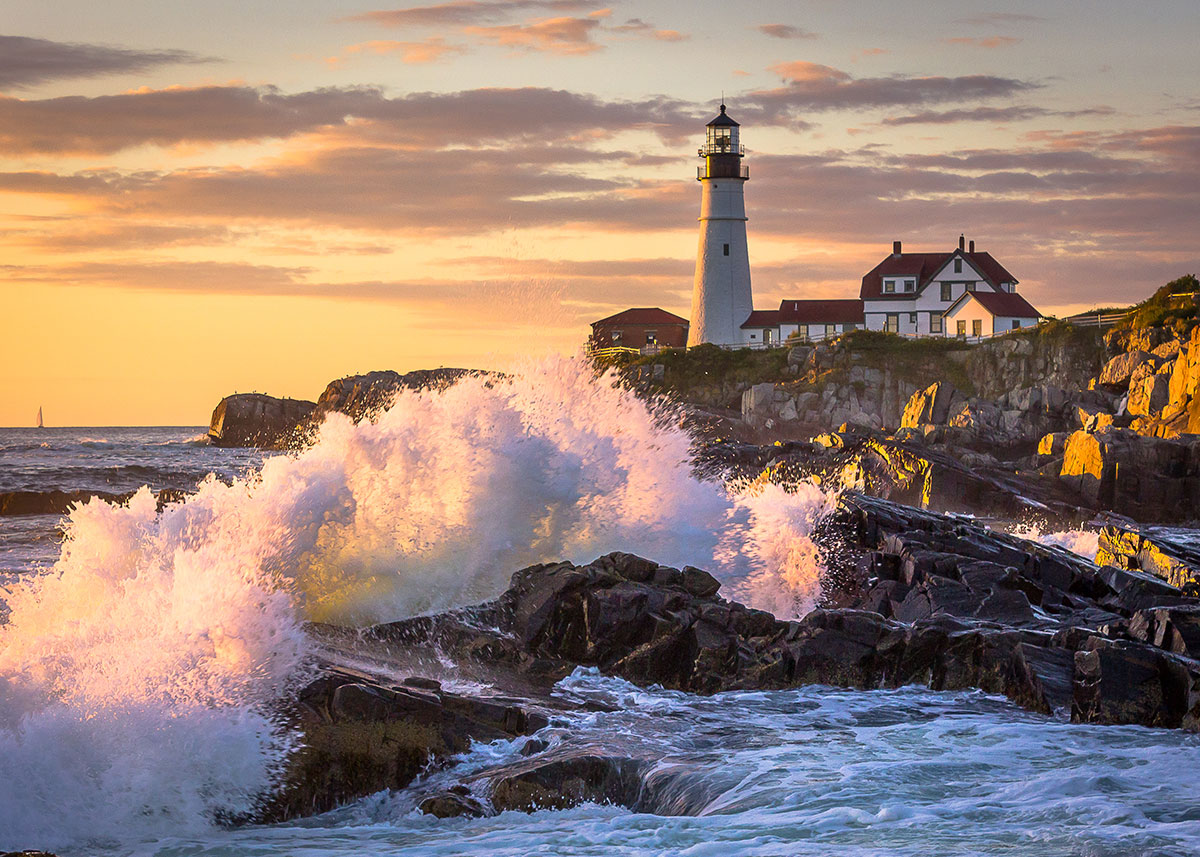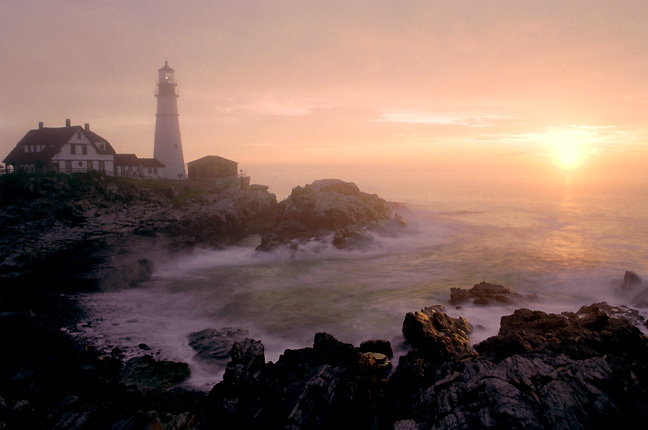Portland Head Light, Cape Elizabeth, Maine
When you visit the promontory where the lighthouse is located, you'll see an interesting rock formation that looks like petrified wood. However, it's made of alternating layers of quartzite and dark grey phyllite. As you look out over Portland Harbor and Casco Bay, you can also spot four more lighthouse towers. To your left (North) is the Spring Point Ledge Light, which was built in 1897 and is located at the end of a rock breakwater. Directly in front of you is the Ram Island Ledge Light, which was constructed in 1905 and is now powered by solar energy. During storms, the waves crash over the top of its lantern room. About 10 miles out, and visible only on a clear day, is the Halfway Rock Light Station, which was first lit in 1871 and is located halfway between Cape Elizabeth and Cape Small. If you look to your right (South), you'll see the Cape Elizabeth Light, one of two towers that were originally built. The remaining operating tower was first lit in 1874.
Portland Head Light with Spring flowers - Photo by: Cindy Farr-Weinfeld
The Wave - Photo by: Benjamin Williamson
During the American Revolution and up until WWII, the armed fortification of Portland Harbor was crucial. If you look north, you will see Fort Gorges situated on a small island in the harbor. The fort was built during the Civil War, but by the time it was finished, the war had already ended, rendering the fort obsolete. Adjacent to Spring Point lies Fort Preble, which was built in 1808. Across the harbor from Fort Preble is Fort Scammel, also built in 1808, located on House Island. Fort Scammel was also the site of a US Immigration Quarantine Station from 1907-1937. Lastly, the park you are currently in was the site of Fort Williams, which went into service in 1898, and was in use until 1962. The fort grounds provide numerous walking paths, a cliff walk offering spectacular views, and a newly planted Arboretum.
Portland Head Light scaffolding restoration, May 2016 [completed June, '16] - Photo by: Cindy Farr-Weinfeld
Scaffolding restoration, May 2016 [completed June, '16] - Photo by: Cindy Farr-Weinfeld
Construction workers on scaffolding, May 2016 [completed June, '16] - Photo by: Cindy Farr-Weinfeld
Small excursion boats slow down to allow their passengers to take pictures as they pass by. Visitors on land often find themselves taking pictures of people taking pictures of them. Larger commercial ships also visit the port, including an average of 80 cruise ships per season, especially in September and October.
The brightly colored buoys bobbing in the water around the point are used to mark lobster traps. You may have the opportunity to see lobstermen pulling their traps as they do this several times per week.
On overcast days when the fog settles in, you might hear the melancholic sound of the foghorn. This sound reminds us of the importance of the light stations and the dedication of the men and women who served through the years.


![Portland Head Light scaffolding restoration, May 2016 [completed June, '16] - Photo by: Cindy Farr-Weinfeld Portland Head Light scaffolding restoration, May 2016 [completed June, '16] - Photo by: Cindy Farr-Weinfeld](https://portlandheadlight.com/wp-content/uploads/portland-head-light-scaffold-may-2016-01.jpg)
![Scaffolding restoration, May 2016 [completed June, '16] - Photo by: Cindy Farr-Weinfeld Girls walk by Portland Head Light scaffolding restoration, May 2016 [completed June, '16] - Photo by: Cindy Farr-Weinfeld](https://portlandheadlight.com/wp-content/uploads/portland-head-light-scaffold-may-2016-02.jpg)
![Construction workers on scaffolding, May 2016 [completed June, '16] - Photo by: Cindy Farr-Weinfeld Construction workers on scaffolding, May 2016 [completed June, '16] - Photo by: Cindy Farr-Weinfeld](https://portlandheadlight.com/wp-content/uploads/portland-head-light-scaffold-may-2016-03.jpg)
